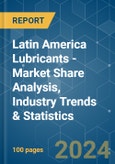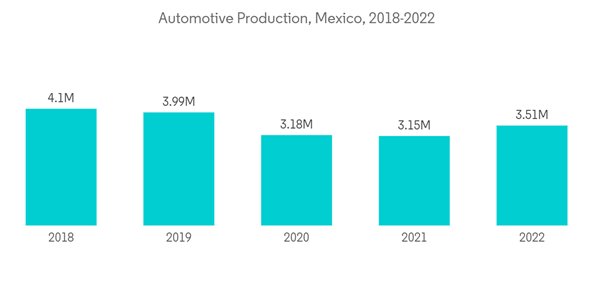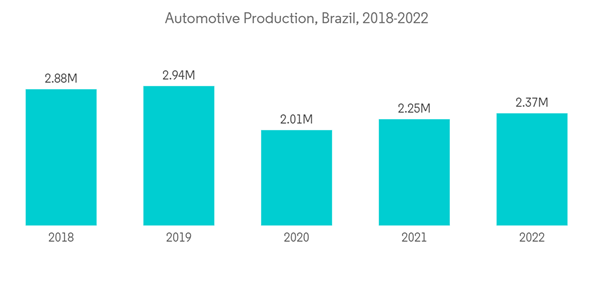Increasing demand for high-performance lubricants and growing demand from Construction and Power Generation Industries are driving the market. On the flip side, the growing adoption of electrical & hybrid vehicles, an increase in the life-time of lubricants, and stringent environmental regulations coupled with unfavorable conditions arising due to the COVID-19 outbreak are hindering the market growth.
Key Highlights
- The lubricant market in Latin America is expected to grow during the forecast period owing to its wide range of applications in different end-user industries including construction and power generation industries.
- Brazil is expected to dominate the market across Latin America with the largest consumption of lubricants.
Latin America Lubricants Market Trends
Automotive Segment May Witness Significant Market Growth
- Engine oils are crucial in the smooth running of engines, reducing fuel emissions and improving the engine's performance, and they are generally composed of 75-90% base oils and 10-25% additives.
- Engine oils are mostly used in applications such as wear reduction, corrosion protection, and smooth operation of engine internals. They function by creating a thin film between the moving parts to enhance heat transfer and reduce tension during the contact of parts.
- The light motor vehicle segment records the highest consumption rate of engine oils among all the segments. Owing to the technological improvements and government-mandated requirements for fuel economy, the automakers have been manufacturing lighter vehicles with tighter tolerances (which make the vehicles more durable).
- High-mileage engine oils are in demand lately, owing to the properties that help prevent oil leaks and reduce oil consumption.
- The automotive industry is one of Mexico's most important industries, accounting for 3.5 percent of the country's gross domestic product (GDP), 20 percent of manufacturing GDP, and employing over one million people nationwide. According to OICA, automobile production in Mexico witnessed an increase of 10% in 2022. The country produced 3,509,072 cars and passenger vehicles in 2022 compared to 3,145,653 units in the previous year.
- Also, in September 2022, the Argentine Congress passed Law 27.686 ('Ley de Promoción de Inversiones en la Industria Automotriz-Autopartista y su Cadena de Valor') promoting investment in the automotive industry and its value chain.
- According to Law 27.686, Argentina's automotive industry is now designated as a strategic sector. The new law encourages investment in the automotive identification industry and strengthens its supply chain. At the same time, it will increase the industry's export-oriented profile and encourage and facilitate the development of new clean engine technologies (hybrids, hydrogen, biofuels, etc.).
- Hence, owing to the growing application of engine oils in vehicles to reduce wear and tire, the demand is expected to increase over the forecast period.
Brazil to Dominate the Market
- During the forecast period, Brazil is expected to dominate the lubricant market in Latin America due to increased demand from end-use industries such as construction, automotive, and automotive.
- Turbines play a key role in the energy sector for generating electricity. A large amount of heat is emitted from the turbine during electricity production. Other than turbines, the major components used in the power generation sector include pumps, bearings, fans, compressors, gears, and hydraulic systems, which are subjected to severe wear and tire. Gear and turbine oils are widely used in this sector for lubrication purposes.
- According to the Brazilian Institute of Geography and Statistics (Portuguese: Instituto Brasileiro de Geografia e Estatística (IBGE), construction GDP in Brazil fell to USD 1501.75 million in the third quarter of 2022 from USD 1526.80 million in the second quarter. Moreover, Brazil's GDP from construction is expected to trend around USD 1426.66 million in 2023. Several construction projects were commenced in Brazil in 2022, which can create ample opportunities for the market studied in the country.
- In the construction sector, lubricants prevent premature failure and decline in construction equipment performance subjected to extremely harsh operating conditions involving heat, dirt, and moisture.
- Lubricants perform various functions to safeguard construction equipment from bearing failures, short life-span of engine oil, lower resistance of diesel fuel to water, and rusting of cables, ropes, and draglines.
- According to the Brazilian Association of Automobile Manufacturers (Portuguese: Associação Nacional dos Fabricantes de Veículos Automotores (ANFAVEA), October 2022 witnessed a steady increase in production, registration, and export indicators compared to the previous month.
- Notably, in the first ten months of 2022, Brazil experienced a 32.4% surge in passenger car exports, amounting to 406,000 units, surpassing the figures from 2021. Countries like Chile, Colombia, and Mexico were noteworthy export destinations for the Brazilian automotive industry.
- The aforementioned factors, coupled with government support, are contributing to the increasing demand for the lubricants market in the Brazil region during the forecast period.
Latin America Lubricants Industry Overview
The Latin America lubricant market is fragmented with players accounting for a marginal share of the market. Few companies include Chevron Corporation, Exxon Mobil Corporation, BP p.l.c, Valvoline Inc., and Total.Additional Benefits:
- The market estimate (ME) sheet in Excel format
- 3 months of analyst support
This product will be delivered within 2 business days.
Table of Contents
Companies Mentioned (Partial List)
A selection of companies mentioned in this report includes, but is not limited to:
- BP p.l.c
- Chevron Corporation
- Eni SpA
- Exxon Mobil Corporation
- FUCHS
- Kluber Lubrication (FREUDENBERG)
- Royal Dutch Shell PLC
- Schlumberger Limited
- Total
- Valvoline Inc.
Methodology

LOADING...










